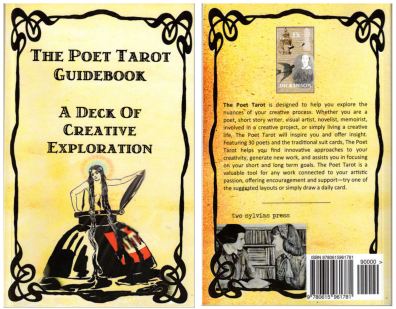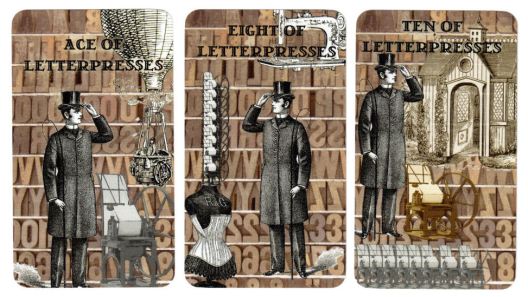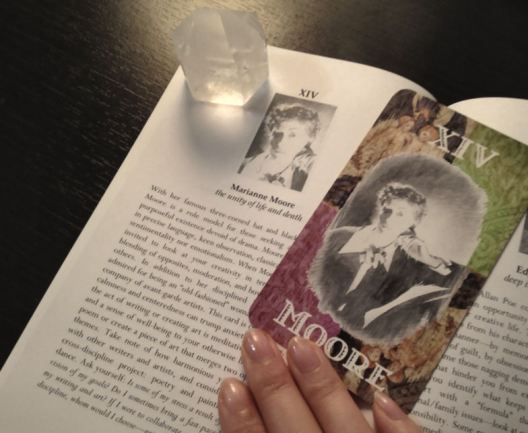
The Poet Tarot published by Two Sylvias Press has just made its debut at the 2014 AWP Conference in Seattle. It was created by Kelli Russell Agodon, who is herself a writer, editor, and poet, and Annette Spaulding-Convy, also a poet. I received an advance review copy and am loving it! This will be one of those amazing decks I use when reading for poets, writers, and artists.
There may be some debate as to whether the Poet Tarot is a tarot deck or whether it is an oracle deck, but more on that later. I tend to see it more as an oracle deck for reasons I’ll explain.
The deck comes in a yellow organza drawstring pouch along with a guidebook, and you will definitely need the guidebook. The dimensions of the cards are about 2.75″ x 4.75″, which for me is the perfect size to shuffle with. They’re very snug in the hands. The guidebook is 5″ x 8″ and while that would not bother me ordinarily, I can’t imagine using the Poet Tarot deck without the guidebook, and so for that, if both were the same size, I could put both in the same pretty cedar box and keep them together on my writing desk, no problem. I have to imagine that as writers come, I’m not alone in that sentiment. Due to the specific nature and purpose of this deck, it would just make more sense to have the guidebook be the same size as the cards, with the intention that the two will always accompany one another.
The art of the deck is in a digital collage form that blends Victorian art and imagery with poet busts in a wholly contemporary style. It’s really breathtaking to look through and has a natural appeal to most 21st century writer sensibilities. They’re borderless like many contemporary decks today, and the borderless design suits the deck well.
Once you hold this deck, you’ll know that every aspect of it was designed for the writer in mind. I just want this deck (and its guidebook) in an ornate wood box in the corner of my writing desk next to Strunk & White. You know what I mean?
The cards are subdivided into the Poets (Major Arcana) and the Suits. The Suits are Quills, Muses, Mentors, and Letterpresses, corresponding with Wands, Cups, Swords, and Pentacles respectively. The four suits represent the four stages of the creative writing process: Quills for creation, Muses for inspiration, Mentors for revision, and Letterpresses for completion. I really love the thoughtful way Agodon and Spaulding-Convy have designed the Poet Tarot deck.
The guidebook for the Poet Tarot contains more information than most “little white books” (LWBs). At the end there is a section on how to use the cards, including daily and weekly card draws to use in conjunction with the progress of a creative project. I really like the idea here and leaving the card(s) drawn out somewhere prominent while you write to inspire and motivate you. The cards can also be used with a writing group or workshop, and that instruction was fascinating to me. I never thought of using tarot that way. Then there are several simple spreads to work with. Perhaps the deck creators themselves realized this deck wouldn’t be suitable for full spreads like the Celtic Cross or Tree of Life.
The Majors consist of 22 American and British poets writing in the English language. While the 22 keys of the Major Arcana in the Poet Tarot are certainly inspired by the 22 keys in the traditional tarot deck, the Poet Tarot’s Majors do take on a life of their own and have become their own unique divination system. In the above 3 Majors shown, you’ll see imagery in the background of the cards that reference the tarot correspondence. In Key XV: Poe, for instance, you’ll see a contemporary rendition of the devil (red with horns) for The Devil; in Key XVII: Clifton, you’ll see imagery that calls to mind stars for The Star. Sylvia Plath would have been my choice for The Moon, too.
Quills represent the creation process of writing and correspond to the traditional suit of Wands in tarot. Muses represent inspiration, and correspond to the suit of Cups.
There’s something Marseille about it, though not exactly. For example, the Three of Quills is about creative expansion through travel, so it would seem to follow the western numerological attributions of the number 3, plus taking into account the dignity (i.e., elemental correspondence) of the suit. Recall that Quills here is all about the creation and writing process. Now, had we tried to impose a Rider-Waite tradition of interpretation onto the Three of Quills (i.e., Three of Wands), it doesn’t quite work as well as applying the Marseille system.

Yet of course there is still some overlap with the Rider-Waite. The Eight of Quills according to the Poet Tarot guidebook is about focusing on one project at a time rather than work in a scattered fashion on too many, and never finishing any. (Great advice, by the way.) It does resonate with the Rider-Waite tradition.
I’m also not sure whether the cards are intended to be read with reversals. Sometimes I like to think the card backs will give some indication. Reversible card backs lend themselves better to reading with reversals and when I use a deck that does not have a reversible card back, I may just read all the cards by their essence, and thus do not observe reversals. Here in the Poet Tarot, you have the reversible card backs (love the illustration, by the way) but no instruction in the guidebook about reading with reversals.
The suit of Mentors is perhaps my favorite suit of the Minors. Mentors in the creative writing process represent revision, and so the Mentors, symbolized by keys in the Poet Tarot, correspond with the suit of Swords. The imagery for this suit is stunning and for me, are inspirational. Something about this suit helps me to tap into the unconscious and for me, work the best for one of the guidebook’s instructional reading techniques–to draw cards as you write or create art and go on the rule that you must allow the imagery of the card drawn to inspire something in your work. Whether it’s just my personal aesthetic biases or whether the creators actually put more time and thought into the suit of Mentors, I found the suit to be the most helpful as an oracle deck. When divining for creative projects, I might just separate out the Poets and the Mentors and use that as a mini oracle deck to draw from for insight.
One of the key differences between the three main tarot systems can be found in the assignments for Key VIII and Key XI. In the Marseille and the first Golden Dawn tradition of tarot divination, Key VIII is Justice and Key XI is Force, or Strength. Waite switched the order in his system for theosophical reasons to align the Majors better to the theosophy of the Golden Dawn (I believe, based on what I’ve read). Key VIII in the Waite became Strength and XI became Justice. I’ve also included for comparison the Thoth. It’s the scales pictured in Key XI: Hughes and Langston Hughes’ association with social justice that convinces me that the Poets section is influenced directly by the Waite system, not Marseille or Thoth.
Now, the technicality that might be why the majority of tarot practitioners will not consider the Poet Tarot a tarot deck: there are only 70 cards, not the traditional 78. The creators of the Poet Tarot made a conscious omission of the Pages/Knaves and Knights/Princes. Each suit in the Minors contains only 2 court cards each, a Queen and a King, and they each correspond with a poet, much like the Poets section. The court cards pretty much become an extension of the Majors and based on the guidebook, seem to be interpreted in much the same style as the Poets/Majors section.
The final suit in the Minors, the Letterpresses, or publication, is about manifestation of creativity in the material world, and so it makes sense that they would correspond with the suit of Pentacles. Folks, the Poet Tarot is not a Rider-Waite clone. It is not a clone of any of the prevailing tarot systems with imagery cut and pasted to fit the traditional imagery of one of the existing decks, oh no. I truly believe the Poet Tarot is its own oracle divination system, and that became even clearer once I started reading with the deck.
Reading with the Poet Tarot
Much consideration was devoted to the actual design of the Poet Tarot deck, for sure. The size is perfect. The quality of the cardstock is perfect. There is no sticky lamination that would otherwise render the deck difficult to shuffle like I’ve seen in some of the recent decks. It’s just the perfect tarot deck to shuffle with.
The deck is just beautiful and when you hold it in your hands, you get an incredibly positive, inspirational, and wholly creative energy from the deck, which is why I would recommend every writer and artist to get one for the writing desk. If you’re going to get distracted from your project anyway, rather than check e-mail or surf social media, reach for your Poet Tarot and get yourself grounded in your project again.
Anyway, so I followed one of the reading techniques provided in the guidebook and drew one card from the Poets (Majors) and one card from the Suits (Minors). I’m currently in the early stages of a creative project and hoped that these cards might offer some pointers.
I got John Milton and the Nine of Muses. Before turning to the guidebook, I wanted to see how interpreting the two cards from the Poet Tarot might work using my familiarity with the existing tarot interpretive systems. Well, Key 20 you’ve got Judgement, of realization, epiphanies, and an awakening. Ah. Milton’s Paradise Lost contained themes of judgment and redemption; hence the correspondence with Key 20: Judgement in the tarot. The Nine of Muses would correspond with the Nine of Cups, which is the wish card. The numerological association with 9 here might suggest that things are looking very up for my project, and even the imagery in the card, the flock of birds flying upward and the four leaf clover in the top corner might affirm that indication. Yay.
So then I went into the guidebook to see what the associations are for Milton and the Nine of Muses. In Milton, when that card is drawn, the guidebook says I should reflect on and evaluate my creative life. It is the card of self examination and figuring out what parts of my creative work need an overhaul. It’s about understanding my own creative work in the context of the larger creative community. I like that. I like how the creators of the deck have reinterpreted Judgement, synthesizing it with our understanding of Milton’s biography and oeuvre. The Nine of Muses is about celebrating the harmony of creativity and output.
I have to say– that is apropos advice considering my project’s current status.
I also wondered how well the Poet Tarot would lend itself to a more traditional bibliomancy technique. So taking into consideration the cards drawn, I opened up a book collection of Milton’s poetry I have here in my library and looked for the first sign from the book that is synchronous in some way with the cards I had drawn above. For me that was the poem “Another on the Same”: Here lieth one who did most truly prove / That he could never die while he could move; / So hung his destiny, never to rot / While he might still jog on and keep his trot; / Made of sphere-metal, never to decay / Until his revolution was at stay.
I wrote that stanza out on an index card and posted it near where I write. We shall see where it takes my work and me.
For me, the Poet Tarot is more in line with the divination techniques of the I Ching than traditional tarot. With the Poet Tarot, I’m more inclined to use the deck of cards the way I might toss coins or yarrow stalks for I Ching divination, and then dive into the deck’s guidebook for answers. I’m interpreting more from what is written in the guidebook than I am from the actual imagery of the cards, the cards’ elemental dignities, numerological associations, or other otherwise innate characteristics of the cards. Now of course that could be because I possess little more than a rudimentary familiarity of the poets in the deck. For the Ph.D. in English Literature, the Poet Tarot is going to be easy peasy to use without the guidebook. For the rest of us… probably not so much.
Used as part bibliomancy, part oracle cards, the Poet Tarot is an incredible collector’s item for the tarot enthusiast and a divination tool for poets, writers, and artists that you will want to consult regularly. As the guidebook suggests, I also think it would be a ton of fun to incorporate the Poet Tarot in a writing workshop. I just wish the guidebook came in the same size as the deck so that I could keep both in a tarot box for display and easy access on a bookshelf or my writing desk. Oh, and needless to say, the Poet Tarot is the perfect gift for a writer or poet friend, so definitely keep that in mind when such an occasion for gift-giving rolls around the bend.












Poet Tarot? Wow, that is sooooo cool! 😉
LikeLike
Roxi St. Clair, this deck is tres cool! I’ve been rounding up all my writer friends and drawing cards from this deck for them and texting them photos and interpretations. Feedback has been positive.
LikeLike
Pingback: The Conjuring of a Poet Tarot Deck: An Interview with Two Sylvias Press « Tania Pryputniewicz
Your review on the Poet Tarot is detailed and very helpful! Thanks for cinching my decision to splurge on this most unique and genius product! 🙂
LikeLike
Oh my gosh. I love this. I already employ various fortune-telling tools in my writing life. (Both real and homemade– see recent post: http://cariejuettner.wordpress.com/2014/02/14/is-it-written-in-the-stars-or-maybe-on-a-popsicle-stick/) This just brings it all together. My Magic 8 Ball might be about to get some new company.
LikeLike
That link was an awesome read! Thanks so much for sharing. Definitely get the Poet Tarot. I’m so glad it was born!
LikeLike
I bought this deck on spec because I am a poet, writer,artist and Tarot reader and collector.. perfect! Very please with my deck. I don’t mind the book size as it is good for adding your own notes, I just wish there were the 8 extra cards… not to make it Tarot but to add more poets!!! I agree with you it is a unique oracle deck, and I love it. The majors are well chosen… Cimmungs is a perfect Fool, and Plath is so the moon… I can’t help but think of her poem The Moon and the Yew Tree.
I had already bought this deck before I read your review but you would have sold me it otherwise!
LikeLike
Pingback: Acting the Fool in 2015 | Carie Juettner
Thankfulness to my father who informed me about this web site, this web site is actually awesome.
LikeLike